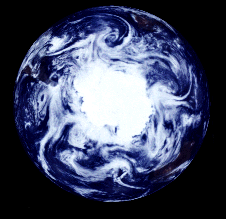

Note: Click on Solar System Exploration: Galileo Legacy Site (NASA-JPL) to get this image at its highest resolution.
This view of the Earth shows a wonderfully unique but physically impossible
view of the southern hemisphere and Antarctica. While a spacecraft could
find itself directly over the Earth's pole, roughly half of the image should be in darkness!
This view was created by mosaicing together several images taken by Galileo
over a 24 hour period and projecting them as they would be seen from above the pole.
The continents of South America, Africa, and Australia are respectively seen
at the middle left, upper right, and lower right.
The slightly bluish ice and snow of Antarctica include large ice shelves
(upper left, lower middle), a broad fan of broken offshore pack ice (lower
left and middle) and continental glaciers protruding into the sea (lower
right). The regularly spaced weather systems are prominent.
Most spacecraft travelling near the Earth's poles are in very low Earth
orbit, and cannot acquire panoramic shots like this one.
Galileo's view of the southern hemisphere, combined with the spacecraft's
special spectral properties (four separate narrowband filters that measure
the brightness of reflected light at specific infrared wavelengths), led to
a number of unique observations.
For example, Galileo's cameras distinguished between ice and high
stratospheric clouds, allowing scientists to study the correlation between
these clouds and growth of the ozone hole.
Although there are many different satellites in Earth orbit monitoring
ground and atmospheric conditions, Galileo's pictures provided a unique
look at our planet.
Galileo can discriminate between water vapor and condensed water in clouds,
pick out diagnostics of the state of health of plant life, and pinpoint
regional differences in land use policy.
Galileo's pictures are also a preview for future remote-sensing systems like the Earth Observing System (EOS), which will make global surveys at high spectral resolution, albeit from low Earth orbit.
Next slide: Western Hemisphere of Moon
Back to: Galileo To Jupiter
Link to: Solar System Exploration: Galileo Legacy Site (NASA - JPL)
Updated: August 18 '96
Best seen with MS Internet Explorer.
Back: ARVAL - Image Gallery
Messages: